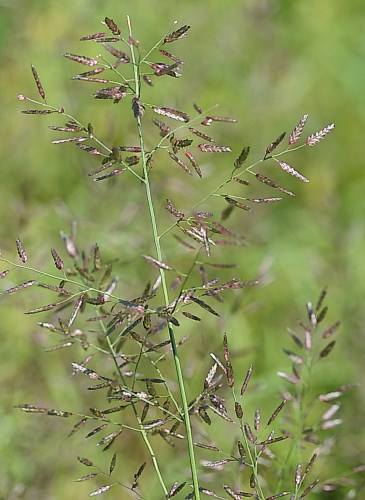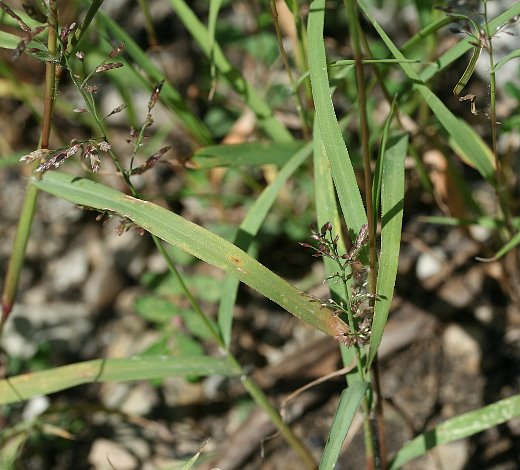
Each culm terminates in a somewhat airy panicle of spikelets that is 1½-4" long and about one-half as much across; in outline, each panicle is narrowly pyramidal to ovoid. The central axis and lateral branches of each panicle are light green, slender, and glabrous. The lateral branches are widely spreading to ascending, dividing into short lateral branchlets that are divergent. At the tips of these branchlets, there are elongated spikelets about 4-10 mm. long and 1.5-2 mm. across. Immature spikelets are light grayish green to dark purple, while mature spikelets become light tan. Individual spikelets are narrowly oblongoid and flattened in shape, consisting of 5-18 florets and their overlapping lemmas (scales with florets) that are arranged in 2 columnar ranks. Each spikelet is slightly less wide at the top than the bottom. At the bottom of each spikelet, there is a pair of glumes (scales without florets). Individual glumes are about 1.5 mm. long, lanceolate in shape, glabrous, and folded along their keels; one glume is slightly longer than the other. Located above the glumes, the individual lemmas are 1.5-2.0 mm. in length. The lemmas are lanceolate-ovate in shape, glabrous, 3-veined, and folded along their keels. Hidden behind each lemma, there is a single floret and a membranous palea. The anthers of each floret are about 0.2 mm. long.

The blooming period occurs from mid-summer to early fall. The florets are cross-pollinated by the wind. Fertile florets are replaced by tiny ovoid grains (up to 1 mm. long); the latter are small enough to be blown about by the wind. The shallow root system is fibrous. At favorable sites, this grass often forms colonies by reseeding itself.
Cultivation: The preference is full sun, mesic to dry conditions, and barren soil containing gravel or sand. Most growth and development occurs during the summer. Because of its C4 metabolism, this weedy grass is able to tolerate hot dry conditions.
Range & Habitat: The non-native Lesser Love Grass is occasional to locally common throughout Illinois; it is probably more common than official records indicate. This grass was accidentally
Faunal Associations: The following information applies to Love grasses (Eragrostis spp.) in general. These grasses are one group of host plants for the caterpillars of Poanes hobomok (Hobomok Skipper) and Poanes zabulon (Zabulon Skipper). Because they often grow in dry open areas where grasshoppers occur, occasionally their foliage is eaten by such species as Melanoplus sanguinipes (Migratory Grasshopper) and Orphulella speciosa (Slant-faced Pasture Grasshopper). Other insect feeders include the aphid Colopha ulmicola and the flea beetle Chaetocnema pulicaria (Thomas, 1877; Clark et al., 2004). Most species of love grass, including Lesser Love Grass, provide poor forage for cattle and other mammalian herbivores, although they will be eaten when little else is available.
Photographic Location: Along a railroad in Urbana, Illinois.
Comments: Another scientific name of this grass species is Eragrostis poaeoides. Love Grasses (Eragrostis spp.) are often difficult to identify. One key characteristic of Lesser Love Grass is the presence of glandular droplets along the margins of its leaf blades. It shares this characteristic with another introduced species, Stinkgrass (Eragrostis cilianensis), which is similar in appearance. Stinkgrass resembles a large version of Lesser Love Grass with an inflorescence that is more compact and cluttered. It usually has more lemmas per spikelet (10-40) and its lemmas are longer (2.0-2.5 mm. in length). Stinkgrass usually has glandular droplets along the margins of its spikelets, while Lesser Love Grass usually lacks this characteristic. Both of these species belong to a group of Love Grasses with the following two characteristics: 1) their lemmas disarticulate individually from the spikelets, while their paleas are often persistent, and 2) disarticulation of the lemmas proceeds from the bottom of a panicle of spikelets to the top. More more information, see Efloras, Flora of Pakistan (www.efloras.org).